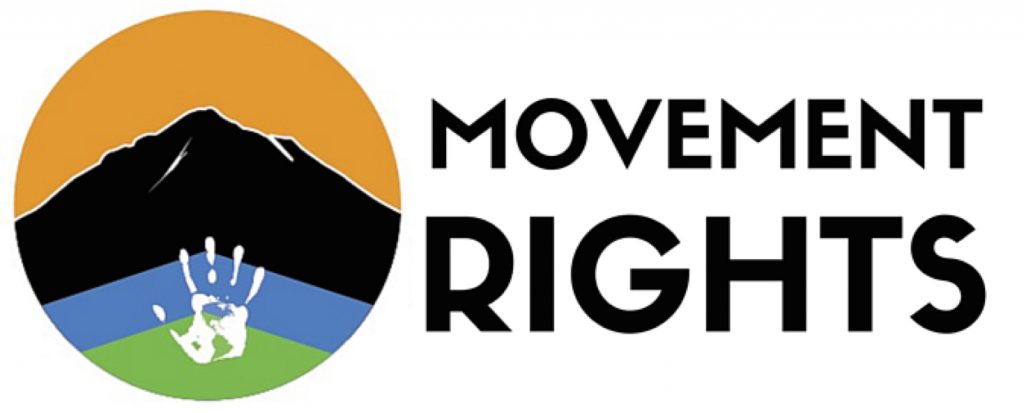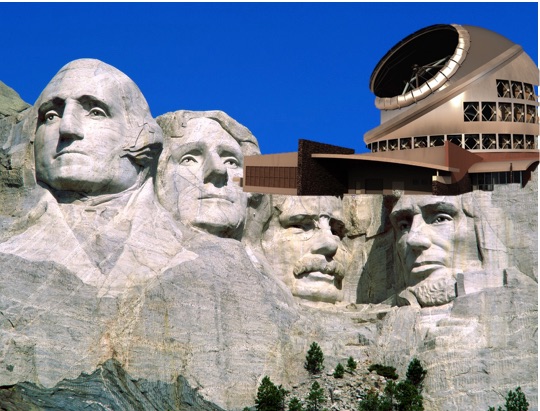By Shannon Biggs, co-founder and director, Movement Rights

They say that Hawaii is Earth’s connecting point to the rest of the Universe. Telescopes—those located on Earth and those in orbit—have allowed us to see deep into the galaxy and to the edges of the universe, sparking our scientific imagination. Owing to its low light pollution, its remoteness and sheer height, some astronomers consider Mauna Kea, a dormant volcano on the island of Hawaii, an ideal place to build the world’s most powerful on-land space observatory, known as the Thirty Meter Telescope (TMT). However, for many native Hawaiians (and non-natives alike) Mauna Kea is far more than a convenient place to construct an 18 story telescope—it is the most sacred place in all of the islands. The TMT represents an offense to Aloha ʻĀina, the love of land that is central to ancient Hawaiian cosmology and culture.
Mauna Kea, the tallest mountain on Earth measured from the sea floor, stands in the center of a fierce battle between the values of modern scientific discovery (backed by the int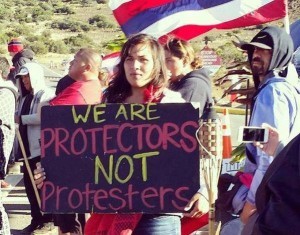 ense political and financial might of several countries) and the values of Hawaii’s traditional and spiritual stewardship of this sacred place (backed by a growing international movement of “protectors” fueled by social media).
ense political and financial might of several countries) and the values of Hawaii’s traditional and spiritual stewardship of this sacred place (backed by a growing international movement of “protectors” fueled by social media).
Construction of the TMT entails blasting a several-stories hole in the Mauna the size of a 50,000 seat football stadium, and placing endangered species and the fragile ecosystem at further risk. There are already a dozen older, smaller observatories on the mountain, many of which are obsolete, but none of which rival the intrusion represented by the TMT. Funding for the $1.4 billion project comes from Canada, China, India, Japan and the US.
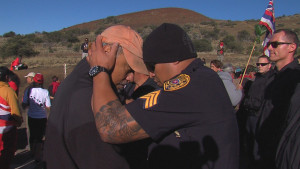
In recent years, a growing number of protectors began holding a constant presence, conducting ceremonies and holding vigil directly opposite the visitor’s station on Mauna Kea. Protectors point out that eventually the TMT will also be obsolete. Even now, a larger observatory is being planned in Chile, and undeniably the best images of the universe already come from satellites in space. While Mauna Kea may be an ideal location, it is not the only possible choice. Regardless, all of the legal hoops were jumped or otherwise eliminated, making way for construction of the TMT in March, but plans were delayed by the first confrontation between police and those standing vigil on the mountain, resulting on the arrests of 31 protectors on April 7 2015.
Then on June 24, in a showing of traditional Haw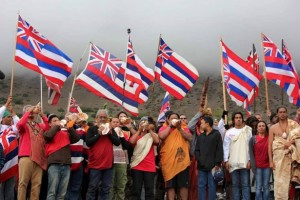 aiian solidarity and self-determination not seen since the US annexation of the islands in 1897, 750 people peacefully blocked the path of construction machinery. Protectors formed 24 separate lines of resistance across the road. Police made arrests at each blockade, allowing the trucks to inch forward, until they met with a blockade of boulders, at which point they turned back.
aiian solidarity and self-determination not seen since the US annexation of the islands in 1897, 750 people peacefully blocked the path of construction machinery. Protectors formed 24 separate lines of resistance across the road. Police made arrests at each blockade, allowing the trucks to inch forward, until they met with a blockade of boulders, at which point they turned back.
Back in September 2014 like most people living outside Hawaii, I was unaware of this epic clash between money, science and the sacred. Having made the pilgrimage to New York City with hundreds of thousands of people for the world’s largest climate convergence, I found myself speaking on a panel of mostly Native Americans discussing our work for rights of nature—a new legal and cultural framework for environmental protection that recognizes legal standing for ecosystems. Near the end of the panel, a woman I had never met stood, introducing herself as Pua Case, a Mauna Kea protector. She said she didn’t know 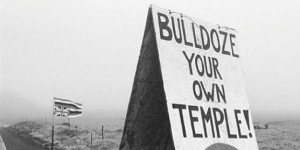 anything about legal standing for rights of nature, but that she had gone to court on behalf of the spiritual rights of Mauna Kea, home to many Hawaiian deities, including Wakea, the Sky Father and the thunder beings, and the said burial site of Hawaiian people’s most sacred ancestors. She looked around the room and asked, “Would you bulldoze your own temple? Because that is what is happening where I come from.”
anything about legal standing for rights of nature, but that she had gone to court on behalf of the spiritual rights of Mauna Kea, home to many Hawaiian deities, including Wakea, the Sky Father and the thunder beings, and the said burial site of Hawaiian people’s most sacred ancestors. She looked around the room and asked, “Would you bulldoze your own temple? Because that is what is happening where I come from.”
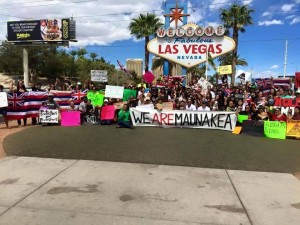
Pua Case related her story to a rapt room—telling of her home in Waimea, that sits in the shadow of Mauna Kea. She told us of the sacred rain rock, or pohaku, in Waimea where her community prays—and upon which in 2009, the goddess of the lake on Mauna Kea appeared to her then 11-year old daughter, Kapulei—prevailing upon the young girl to relay a message to her mother to ‘please try to stop the building of the telescope.’
“What telescope?” Pua asked her daughter.
And so the several-year struggle began. Through the chaos of New York’s climate week and home, I carried with me Pua’s story. Over the next months, the story of the #WeAreMaunaKea protectors exploded globally via twitter and Facebook, and ultimately compelled me to visit Mauna Kea and Pua Case.
When the World Was Flat
Like much of traditional knowledge, ancient astronomy was discarded as “primitive” only to be later “(re)discovered” as science using acceptable western technologies. Hundreds of years before Captain Cook sailed to Kealakekua Bay bringing spyglasses, compasses and the like, knowledge of the night sky was already deeply imbedded in Hawaiian culture.
In fact, while Europeans were still arguing over whether or not the earth was flat, as early as 300 AD Polynesian and Hawaiian navigators were circumnavigating the globe in double-hulled canoes using their knowledge of the stars.
Peter Apo, a sitting trustee of the Office of Hawaiian Affairs, owner of a consulting company for the tourist industry and a proponent of the TMT project sites this scientific history as a reason to move forward with the project. “The construction of the [TMT] represents one of the greatest quests for knowledge in the history of mankind,” Apo has said. “Arguments that this project constitutes a grievous cultural and religious injury to Mauna Kea seem to fly in the face of historical practices by Hawaiians. The search for knowledge has always been fundamental to Hawaiian society.”
And while star gazing and other scientific knowledge has been historically important in traditional Hawaiian culture—it is connected to the spiritual beliefs and creation stories that spell out humanity’s intimate relationship with the rest of the natural world. Lorilani Keohokalole-Torio, a teacher, artist and advocate for ancestral teachings, believes the struggle isn’t about being agai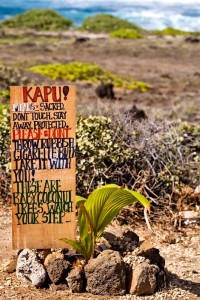 nst science. “With opposition coming from all sides, the many facets of the movement now has been to take all the issues we are faced with and find balance. … It’s about Kapu Aloha … taking responsibility for one’s actions.” As Case explains, for the protectors holding vigil Kapu Aloha specifically “dictates how one conducts themselves on the sacred temple, that which is the mountain itself … an order of behavior interwoven into the highest dignity and respect, to carry oneself as if their ancestors were standing amongst them.” An ancient proverb He ali‘i nō ka ‘āina, ke kauwā wale ke kanaka
[The land is the chief, the people merely servants] demonstrates the spiritual and moral obligation to protect Hawaiian ecosystems.
nst science. “With opposition coming from all sides, the many facets of the movement now has been to take all the issues we are faced with and find balance. … It’s about Kapu Aloha … taking responsibility for one’s actions.” As Case explains, for the protectors holding vigil Kapu Aloha specifically “dictates how one conducts themselves on the sacred temple, that which is the mountain itself … an order of behavior interwoven into the highest dignity and respect, to carry oneself as if their ancestors were standing amongst them.” An ancient proverb He ali‘i nō ka ‘āina, ke kauwā wale ke kanaka
[The land is the chief, the people merely servants] demonstrates the spiritual and moral obligation to protect Hawaiian ecosystems.
Unlike western science, often undertaken in white lab coats and sterile petri dishes, ancestral knowledge is not divorced of morality and connection with the earth or the Sacred. That science, (itself a western word) in the hands of indigenous peoples is often discredited by “modern” scientists isn’t a sign of progress—but hardwired remnants of colonization and dominion over nature, people and knowledge. Francis Bacon himself, the father of the Scientific Method wrote that his “only earthly wish is to stretch the deplorably narrow limits of man’s dominion over the universe” by “putting her (nature) on the rack and extracting her secrets.”
In terms of understanding nature—many of the secrets Bacon and today’s TMT scientists seek to unravel have been well understood by traditional peoples guided by Earth-based spirituality that sees humans not as owners of nature, but rather in relationship with the natural world. As Tom Goldtooth, director of the Minnesota-based Indigenous Environmental Network has said, “I believe that as Native people, we are the land and the land is us.” Goldtooth, also an advocate of Rights of Nature continued to say,
“Those of us in the environmental justice movement have started to educate the larger environmental movement that our work protecting the environment is spiritual work. When we talk about the environment, very often we are talking about sacred elements. We’re talking about air, which is a gift from the Creator.”
The Sacred science of the Pohaku
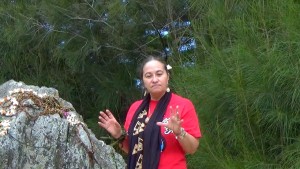
Pua Case is among many things, the founder of Hawaii Warriors Rising, part of the international indigenous Idle No More movement. After clearing the debris and placing fresh leis as offerings on the pohaku at Weimea, with cars whizzing past on the highway just beyond a slim row of trees, I watched as Pua Case offered a prayer to the beings that dwell on what a visitor could be forgiven for identifying as an ordinary rock. There are no markers other than the leis to indicate the specialness of this place.
“My child was open,” says Case of her daughter’s ability to see and communicate with the water being warning of the impending TMT. “She had not ‘learned’ [to reject spiritual connection with nature], her mind was not colonized.” She explained that Mo’o I Nanea is the name of the water spirit of Lake Waiau near Mauna Kea’s summit that comes down from the summit occasionally to sunbathe on the Waimea pohaku. The truth of Kapulei’s visions were never a question for her or for her community.
“These are the things we know. The things we keep secret. And today, it is not for me to worry about where you are at or whether you believe—whether this sounds like a fairy tale. We’re not trying to convince you if what we say is true. We’re standing for a mountain. We can no longer keep our stories secret.”
For Case, initially what she felt was fear. “What would it mean to stand for the mountain? What about my job?” she recalls asking herself. “What about the jobs? What about my safety, would I have to go to court? What if no one stood with me?”
From 2009 to 2015 six petitioners including Pua and her family (the Flores-Case ‘ohana) entered into a court case, with The Flores-Case ‘ohana acting on behalf of the spirit world and Mo’o I Nanea, the water spirit. “In court, we lost. Everytime. And we understood that would most likely happen,” says Pua with a gentle shrug. “The courts are not set up for us, especially when money is involved.” They lost not only on the spiritual claim, but on the basis of environmental protections; Mauna Kea is designated conservation land. Despite this, over many years 13 telescopes were quietly built on the summit, and even officials concede there were clear violations of conservation and native sovereignty laws.
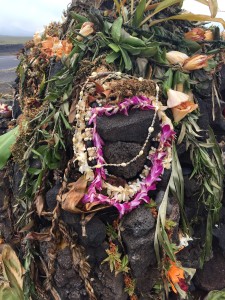
Funds were sent in from around the world to pay for portable toilets for the protectors. Those toilets were removed by the Department of Land and Natural Resources in further retaliation for the June 24th blockade. Respecting the mountain means protectors are guided to find other methods to take care of their bodily needs.
A nighttime curfew was also put into place in another attempt to keep all people off the mountain. Throughout it all, protectors are reminded to act in the spirit of Kapu Aloha, leaving anger or negativity off of the summit. “That’s been a challenge,” says Case, who along with other leaders, have been traveling to speak out about the Mauna, in between leading traditional chants for protectors and the spirits, “But also a beautiful part of our training, particularly for those seeking to help who are unfamiliar with the expectations of Kapu Aloha.”
 Then on July 18, Mauna Kea had a say. In the middle of hottest summer in memory, there was a snowstorm on the mountain. “This is my confirmation that we are on the right path,” Joshua Lanakila, one of the protectors, told the media. “We are our land, and our land is us. When we move, the land reflects our movement, and vice versa.” Ku’uipo Freitas wrote on Facebook, “It’s summer in Hawaii and Poliʻahu, the snow goddess, came to grace us in mid-July, the hottest month of the year. This is the power of pule (prayer) and believing in your culture and where you come from.”
Then on July 18, Mauna Kea had a say. In the middle of hottest summer in memory, there was a snowstorm on the mountain. “This is my confirmation that we are on the right path,” Joshua Lanakila, one of the protectors, told the media. “We are our land, and our land is us. When we move, the land reflects our movement, and vice versa.” Ku’uipo Freitas wrote on Facebook, “It’s summer in Hawaii and Poliʻahu, the snow goddess, came to grace us in mid-July, the hottest month of the year. This is the power of pule (prayer) and believing in your culture and where you come from.”
The snowy reprieve from construction was brief, and to add insult to injury, the next police action came on July 31—the Eve of Hawaiian Sovereignty Day. The raid took place in the middle of the night on Mauna Kea, and in Maui, where another telescope is being erected. Protectors in both places peacefully chanted and laid their bodies before the trucks, carried off one by one by groups of police. A total of 27 were arrested.
in the middle of the night on Mauna Kea, and in Maui, where another telescope is being erected. Protectors in both places peacefully chanted and laid their bodies before the trucks, carried off one by one by groups of police. A total of 27 were arrested.
For those standing for the mountain, no matter the outcome, the fight isn’t about science versus nature. “They’ll play that card until the last day,” says Case. “If you don’t believe in the Sacred, or culture, that’s fine. If you don’t care that laws have been broken and criteria to build a conservation zone have not been built, thats up to you. But this is our watershed, our aquifer for the next seven generations. For us there can be no compromise for what we believe in, what we know to be true. There is no negotiation. We will stand as our kapuna have instructed us at the time of annexation, to stand until the last Aloha ʻĀina patriot lives.”
To support the protectors, visit their Facebook site and leave your own message of solidarity, which helps fuel the community’s spirits, or you can order a Protect Maua Kea shawl.
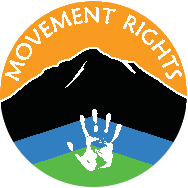 Movement Rights assists communities confronted by harmful corporate projects to assert their right to make important decisions that impact them by passing new laws that place the rights of residents (and nature) above the claimed legal “rights” of corporations. At the heart of our work is the belief that asserting our right to create the kind of place we want to live and reining in corporate power is the next evolution of the civil rights movement. Over 160 communities across the United States have already asserted their right to local self-government and stopped unwanted harms.
Movement Rights assists communities confronted by harmful corporate projects to assert their right to make important decisions that impact them by passing new laws that place the rights of residents (and nature) above the claimed legal “rights” of corporations. At the heart of our work is the belief that asserting our right to create the kind of place we want to live and reining in corporate power is the next evolution of the civil rights movement. Over 160 communities across the United States have already asserted their right to local self-government and stopped unwanted harms.
Movement Rights is a fiscally sponsored project of the Oakland Institute. We are supported by individual donations and small foundation grants. Please consider supporting our work and joining our list serve to keep up to date on the movement for rights-based change. Thank you!
